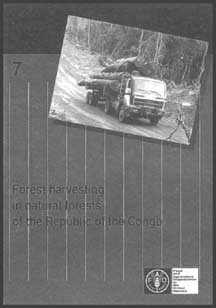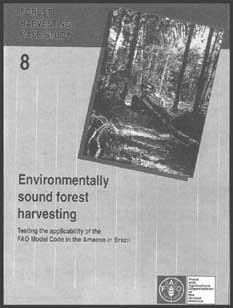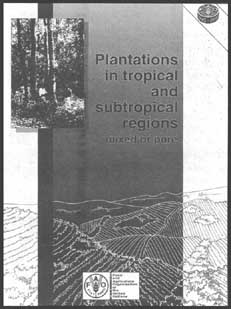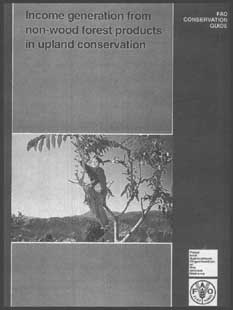Forest harvesting in the Republic of the Congo
Results of environmentally sound forest harvesting use in the Amazon region
Plantations: Pure or mixed?
Non-wood products: Sources of income in upland regions
Forest valuation: Combating deforestation and forest degradation
Forest harvesting in natural forests of the Republic of the Congo By Robert Sharpenberg 1997 Forest Harvesting Case-Study No 7 Rome, FAO.

Timber harvesting is an important step in the management of forests. FAO assists member countries, institutions and forest companies to improve timber harvesting and lower its impact on soil and the remaining timber stands through its Model Code of Forest Harvesting Practice. Experience demonstrates that harvesting performance can be improved and, at the same time, negative harvesting impacts reduced.
This report is a case study on forest harvesting in the natural forest of the Republic of the Congo. It is part of a series of case studies published by FAO in the field of forest harvesting. The analysis was undertaken in collaboration with a private industrial enterprise. The principle objective of the study is to aid the development of sustainable forest management in the tropics through the establishment of credible data on forest harvesting practices and harvesting impacts in tropical high forests.
The report analyses firsthand information on time and work studies as well as information provided by technical and management staff of Société Congolaise des Bois (SOCOBOIS). The study is divided into three parts: i) a study inventory; ii) a harvesting performance study; and iii) a harvesting impact assessment. The first section covers information currently available on the forests of the study region and their growth. The second section includes an extensive analysis of wood recovery. The third, on harvesting impact assessment, evaluates the road and skidtrail network and offers a harvesting damage survey as well as a simple soil disturbance evaluation. It also presents a felling time analysis. Photographs illustrate the work performed.
The documentation is based on 150 ha of closed broad-leaved forest that is part of a 140000 ha concession area located in the southern Congo. The main product harvested in this region is okoumé (Aucoumea klaineana), an important species for veneer production in the plywood industry. The average harvesting intensity in the study area is approximately 6 m3 of net log volume per hectare. As with any harvest operation, by placing high priority on harvest planning and assessment, it is possible to come closer to the goal of sustainable forest practices.
This case study should be of high value to countries and companies interested in introducing sustainable forest management practices in the tropics.
Environmentally sound forest harvesting: testing the applicability of the FAO Model Code in the Amazon in Brazil. By Rudolf Heinrich with Ronnie de Camino. 1997. Forest Harvesting Case-Study No. 8. Rome, FAO.

Improved forest harvesting practices that give due consideration to the forest environment are an important step towards sustainable forest management. This is particularly the case in tropical regions such as the Amazon forest of Brazil.
This case study compares the efficiency and environmental impacts of environmentally sound forest harvesting in the tropical natural forest of the Amazon in Brazil with the logging systems usually adopted in this area.
A further objective of the study was to test the applicability of the FAO Model Code of Forest Harvesting Practice (developed by FAO in 1995) for each phase of the harvesting operations as applied by a company working on a commercial basis. The code is intended as a compendium of modem techniques of environmentally sound harvesting practices. It is meant for general use where more specific regional codes are missing or existing laws and rules are insufficient to attain low-impact harvesting.
In the case study, two adjacent plots within a single forest stand located about 227 km east of Manaus in Brazil were harvested, one using traditional methods and one using environmentally sound practices as described in the FAO Model Code.
The outcome of the study clearly demonstrates that environmentally sound forest harvesting in tropical forests is a good alternative to the traditional and often destructive logging systems commonly used in the Amazon region in Brazil. As might be expected, the sustainable techniques are superior in terms of meeting environmental needs. For example, soil disturbance was restricted to about 4.5 percent of the cutting unit area under sustainable practices while, with traditional methods, it was extended to 20 percent of the total area. Using sustainable practices, canopy opening came to about 11 percent of the area, with reasonably sized gap openings, compared with 25 percent under traditional methods, with several critical-sized gaps.
Of particular note is the fact that the sustainable practices also produce better results from an economic point of view. Under the environmentally sound forest harvesting systems total timber losses come to 3.9 percent of the utilizable stem volume, whereas they reached 8.5 percent when the traditional logging method was carried out. Harvesting damage to potential crop trees (those left for harvest in future interventions) under sustainable practices was less than half that with the traditional logging system (22 compared with 53 percent), thus establishing a higher potential value for a subsequent harvest.
Although a case study is just a snapshot, it should raise interest in introducing sustainable forest management practices in natural tropical forests.
Plantations in tropical and subtropical regions: mixed or pure. By T.J. Wormald, K Roberts and J. Troensegaard. 1995. Rome, FAO.

Worldwide, increasing attention is being focused on all matters affecting the environment. In this regard, many long-established forestry practices have been or are being reassessed, and the establishment of forest plantations as blocks of a single species is among the practices that are being reexamined.
In 1991 the FAO Forestry Department, with financial assistance from the Swedish Agency for Research Cooperation with Developing Countries (SAREC), carried out a study on the economic, social and environmental aspects of mixed and pure forest plantations. The results of this study were published in FAO Forestry Paper No. 103, Mixed and pure forest plantations in the tropics and subtropics.
Plantations in tropical and subtropical regions: or pure is a more popular version of that report and is aimed at a wider public. It provides guidance to those responsible for planning and managing plantations. It reviews the advantages and disadvantages of mixed and pure plantations in the tropics and subtropics. The publication also examines and compares field experience of mixed and pure planting, outlining the principles to be followed in establishing forestry plantations of single or mixed species.
The authors emphasize that forest plantations in the tropics and subtropics make a significant contribution to people's needs for forest products and provide environmental services. These associated benefits can afterwards be improved and increased by using mixed species approaches, although generally at the expense of a reduced total wood yield. The authors specificaly note the potential advantages of using mixed species plantations in community forestry as firebreaks and nursery crops and in wildlife conservation.
Notwithstanding a number of proposals made in the paper, there is still a significant lack of experimental evidence on the benefits and limitations attached to forestry undertakings involving mixed and pure plantations in the tropics and subtropics. The study confirms the lack of data available to make direct comparisons and highlights the dangers of making unqualified remarks for or against either sort, of plantation.
Income generation from non-wood forest products in upland conservation. By David A Taylor. 1986. FAO Conservation Guide No. 30 Rome, FAO.

Currently there is increasing recognition of the special challenges of conserving upland watersheds and their biological resources. Development is a special challenge in rugged upland terrain characterized by inaccessibility, climatic variability and fragility of ecosystems. Mountain communities face greater and greater hardship as populations expand, as population growth often exceeds the ability of the natural resource base to support them sustainably, resulting in poverty and malnutrition in upland areas. Experiences in many developing countries show the promise of non-wood forest product (NWFP) activities in helping to alleviate this situation. Thus, two key elements of policy reform are the importance of NWFPs in national accounting systems and the internalization of environmental costs.
This FAO Conservation Guide provides policy-makers and planners with an overview of how NWFP activities can improve upland incomes and provide incentives for wise management of forest resources. The report relies on the results of the Expert Consultation on Non-Wood Forest Products, held in Yogyakarta, Indonesia, 17 to 27 January 1995 and sponsored by FAO and the Government of Indonesia. Highlighting the growing awareness of the need for national conservation and development in upland areas, it is a preliminary work that attempts to place the importance of NWFP activities in the context of upland conservation and development.
The contributors to this document have many years of experience in upland forest conservation. The four-chapter guide documents and analyses the importance of NWFPs and concentrates specifically on dynamics of mountain areas. It then focuses on NWFP activities to establish where upland conservation has been promoted and discusses how these activities have contributed to local, regional and national economic growth. It concludes with an examination of a strategy by which NWFP activities may be guided to enhance income generation and upland conservation. The balance of these objectives requires a sound framework for decision- making and good information on the forest resource. Strong long- term commitments from the communities themselves, government agencies and NGOs is a necessary factor. Contact addresses to promote networking among people working in the wide field related to upland conservation and NWFPs are listed in the Appendix.
This guide provides a sound introduction to and overview of the topic and should be of value to policy-makers and planners who are committed to utilizing the potential of NWFPs more fully for income generation in upland conservation.
Forest valuation for decision-making: lessons of experience and proposals for improvement. By Sebastião Kengen 1997. Rome, FAO.

As a result of the undervaluation of forests, the forestry sector attracts less investment than it deserves. Appropriate valuation, therefore, is crucial to combat deforestation and forest degradation and to promote conservation and sustainable forest development. Valuation studies that contribute to enhancing the management of forest resources should be used in decision-making.
This study documents and analyses the experiences and results of currently available methods for valuation of forests and trees during investment preparation. It discusses the shortcomings of current methodologies in the full valuation of forest products and services. It focuses the reader's attention on the methodologies that are most useful for practical application and it suggests ways in which these can be applied to put the economic contribution of forests and trees on the same level of analytical reliability as that of other land use options.
The publication highlights issues that need to be addressed to transform forestry valuation into an effective tool in formulating forestry development policy and provides guidance on the preparation of forest assessment. Of particular interest is the recommendation of valuation approaches for a range of situations that take into account the need for replicability, cost effectiveness and applicability in the event of poor availability of data. It highlights economies that are not operating fully on a market basis, as is the case in many developing countries.
Forest valuation for decision-making: lessons of experience and proposals for improvement is divided into two parts. The first part, treating the context of valuation, deals with the definition and clarification of the decisions for which assessment is intended to be the basis. It clarifies the purpose of such valuation, including its context and outputs. The second part, treating the valuation process, focuses on the problems of data inadequacy and difficulties of measurement in valuation. It addresses the question of choosing and applying valuation methods and techniques to meet information needs and concludes by mentioning opportunities for further studies. This analysis is based on more than 200 bibliographical references. Values, benefits and costs to consider in forest valuation, examples of recent estimates of forest values and estimates of economic values of forest benefits are listed in the annexes.
The publication aims at two main audiences: decision-makers in investment projects and those responsible for forestry investment projects.